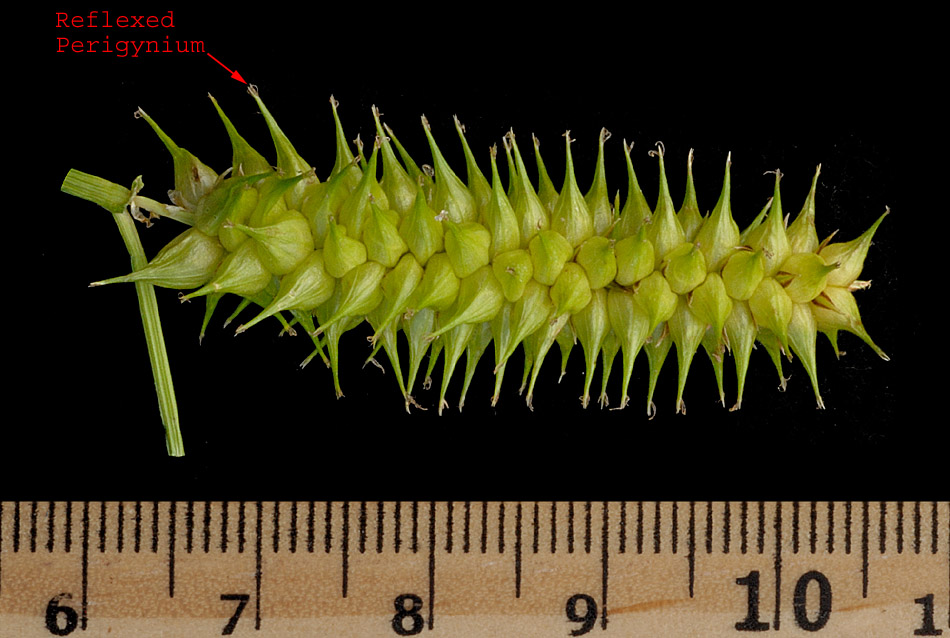 |
Stigmas 3; achenes three-sided,
occasionally terete, though their shape may be concealed by flattened
perigynia. NOT [Stigmas 2; achenes lenticular.] |
 |
Spikes 2 or more per culm, terminal and
lateral; spike bracts present on lateral spikes (except in Section Phyllostachyae),
lowest bract usually evident, often conspicuous. NOT [Spikes 1 per
culm, terminal; spike bracts absent.] |
 |
Lower pistillate scales not bract-like or
leaf-like but similar in size and shape to individual perigynia (up to
twice as long as perigynia in C. magellanica ssp. irrigua).
NOT [Lower pistillate scales resembling green, leaf-like bracts much
longer and wider than individual perigynia.] |
 |
Perigynia glabrous (i.e. lacking
pubescence). NOT [Perigynia sparsely to densely pubescent or puberulent
(in C. pedunculata pubescence represented by very short hairs
scattered near tip; in some species of Sect. Acrocystis,
perigynia may be glabrous or virtually hairless, but all members of this
group have convexly 3-sided to terete achenes with tight fitting
perigynia and a stipe-like base about equal to beak in length).] |
 |
Beak over 0.5 mm long and usually visibly
bidentate (teeth hyaline in C. sprengelii, inconspicuous in C.
viridula, very short in C. oligosperma). NOT [Beak
absent or less than 0.5 mm long; if more than 0.5 mm long, then
terminating in an orifice without teeth.] |
 |
Style continuous with achene and
persisting at maturity as a long, curved or straight prong. NOT [Style
jointed at base and deciduous from achene, if present at maturity,
breaks of readily when manipulated.] |
 |
Perigynia shorter and usually wider,
usually at most only 4 times longer than wide; staminate spikes much
longer than individual perigynia; mostly common species. NOT [Perigynia
long and narrow, (8.7) 10-12.5 mm long, 1.5-2 mm wide, about 6 times
longer than wide with long tapering tip; staminate spike about same
size, or smaller than, perigynia adjacent to it; rare northern species.] |
 |
Perigynia 20-200 per spike; leaves wider,
not wiry; pistillate spikes 2-6, mostly separate to overlapping. NOT
[Perigynia 5-15 per spike; leaves 0.5-2.5 mm wide, involute, wiry;
pistillate spikes few (1-2), remote (or upper overlapping with staminate
spike).] |
 |
Lower pistillate spikes short-stalked or
sessile, erect to ascending; lower part of pistillate scales more
substantial, usually wider than 1 mm with awn shorter than lower part
although those at base of spike can be narrower and long awned. NOT
[Pistillate spikes on filiform stalks, erect or often nodding; lower
part of pistillate scales throughout spike not much more than hyaline
wings along bottom of long awn and no wider than 1 mm.] |
 |
Style base contorted in an S shape;
perigynia 6-15 nerved; ventral strip membranous, not disintegrating into
laddered fibers with age. NOT [Style base straight or somewhat
bent; perigynia 12-26 nerved; ventral strip disintegrating into laddered
fibers with age.] |
 |
Lowest spike bract more than 2.5 times
longer than entire inflorescence; perigynia spreading to reflexed at
maturity; staminate spikes usually 1, extending only several cm beyond
overlapping pistillate spikes clustered at culm tip. NOT [Lower
spike bract less than 2.5 times as long as entire inflorescence;
perigynia ascending to spreading at maturity; staminate spikes usually 2
or more, extending well beyond separate-to-overlapping pistillate
spikes.] |

